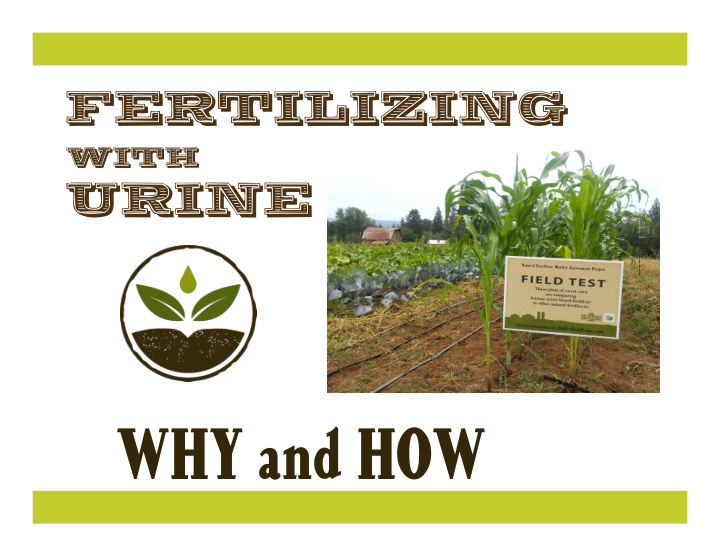



FERTILIZING with URINE WHY and HOW
The The Natural Natural Ferti Fertilizer zer Market Market Ev Evaluation Project was made possible with a grant from Western Sustainable Agriculture Research & Education Western Sustainable Agriculture Research & Education
WHY URINE? Ultimate in Recycling or Upcycling Puts Us Back in the Ecosystem “Fork to Field” closes the loop Valuable Resource Sterile Immediately useful on plants Contains valuable nutrients Universally available
HUMAN NUTRIENT CYCLE When we consume plants, or animals that consumed plants, the majority of nutrients embedded in the plants exit our bodies in our urine.
CURRENT NUTRIENT FLOW
HUMAN NUTRIENT CYCLE
URINE CAPTURE Urine Diverting Toilets
URINE CAPTURE Urine capture with urine diverting toilets: Apartment complex, Sweden
URINE CAPTURE Portable toilets and urinals, France
URINE CAPTURE Krons Urinal for men and women
URINE CAPTURE Krons Urinal - Amsterdam
URINE CAPTURE Unique Urinals
URINE CAPTURE Urinal for women
FORK TO FIELD Pr Produc oductive Sa Sani nitation on Agriculture is historically linked with human derived fertilizers. For centuries, farmers replaced the organic matter and nutrients, removed from the soil through harvested crops, with human excreta. Night Soil Collector, China Biosolids Distribution, USA Night Soil Distribution, China, 1994
FORK TO FIELD Ur Urine ne Nut Nutrient nt Cy Cycling ng – B Benefi fits to Environment •Reduces dependence on synthetic nitrogen fertilizer •Alleviates dependence on finite phosphorus reserves and impacts from phosphorus mining operations. Phosphate Fertilizer Mining Waste, Florida New $1.8 Billion Fertilizer Plant, Iowa
URINE BENEFITS TO AGRICULTURE The composition and bioavailability of nutrients in urine makes it a viable fertilizer for plants.
HUMAN NUTRIENT CYCLE A person releases an estimated 1.5 liters of urine a day. Each liter contains an estimated 5g of nitrogen. Each person produces about 6lbs of nitrogen a year.
HUMAN NUTRIENT CYCLE One person’s urine can fertilize about .09 acres/year, depending on the crop. If all of one’s urine was captured over the year, it could fertilize enough crops to meet 60-90% of one’s annual food needs.
URINE BENEFITS TO AGRICULTURE Primary Macronutrients - NPK Nitrogen (N) Phosphorus (P) Potassium (K) Secondary Macronutrients Sulphur (S04-S) Calcium (Ca) Magnesium (Mg)
URINE BENEFITS TO AGRICULTURE Urine NPK levels will vary depending on diet and exercise In its original state, with 95% water, urine’s average NPK is 0.5 : 0.15 : 0.22 Evaporating the water would result in a dry weight NPK of 10 : 3 : 4
URINE BENEFITS TO AGRICULTURE Urine volume compared to Chicken Manure Application rate 180lb N/acre Urine NPK 0.5 : 0.15 : 0.22= 4300 gallons/acre 6000 lbs/acre Chicken Manure NPK 3:2:2 = Urine dried NPK 10:3:4 = 1800 lbs/acre
URINE BENEFITS TO AGRICULTURE Urine also contains micronutrients , essential for plant growth, but usually missing in fertilizers: Boron (B) Chlorine (Cl) Copper (Cu) Iron (Fe) Manganese (Mn) Molybdenum (Mo) Zinc (Zn)
URINE BENEFITS TO AGRICULTURE Urine Ur ne Co Composition DAY DAY 1 75-90% urea 10-25% ammonium and creatinine DAY 2 DAY 75-90% urea converts to ammonium and carbon dioxide 10-25% ammonium and creatinine The phosphorous and potassium are in ionic forms which can be readily taken up by plants.
URINE APPLICATION Di Dilut ution on Ra Rate Urine can be applied neat or diluted, depending on the crop and the timing. Dilution rates range from 1:1 up to 1:15 urine to water ratio. A 1:3 ratio is the most common. :
URINE APPLICATION Rate of Application Frequency depends on plant, its root size and soil Apply at seeding time or disperse between seeding up to 30 days prior to harvest Multiple smaller applications are good for: • Sandy or fast draining soils • During periods of heavy rainfalls • Plants will small root systems such as lettuce and carrots
URINE APPLICATION Method - Feed the Soil: Farm Scale Urine should be incorporated into the soil as quickly as possible, to minimize ammonia volatilization. For farm scale, equipment like this slurry spreader could be used.
URINE APPLICATION Method - Feed the Soil: Small Scale For small scale/garden scale, urine should be applied in a small furrows or holes near but not touching the seed or plant. Towa Urinal Watering Can
URINE APPLICATION Method - Feed the Soil: Fertigation Urine can be applied via a drip irrigation.
URINE APPLICATION Storage in Mulch The urine can be “stored” in woody mulch (3” or more deep). The high carbon mulch will slow the release of the nitrogen.
FAQs Pa Pathoge hogens ns Urine is primarily sterile when it exits the body. Any potential pathogens can be eliminated through extended storage, in an air tight container, for 6 months, at 68F. When the urine is used on personal plots, no storage is needed. WH WHO Guidelines for the Safe Use of Wa Wastewater, Excreta and Gr Greywater. Volume 4: Excreta and greywater use in agriculture. World Health Organization, Geneva, Switzerland, 2006
FAQs Pha Pharmaceut uticals “The micro-pollutants can be degraded better in the aerobic, biologically active soil layers with long retention times than in water bodies whose ecosystems are much more sensitive.” Richert, A., R. Gensch, H. Jönsson, T.-A. Stenström, L. Dagerskog, with contributions from: M. Kjellén et al. (2010). Practical Guidance on the Use of Urine in Crop Production. SEI, EcoSanRes series: 2010-1.
FAQs Sal Salts Urine is a solution of salts, and salt stress can be a major constraint to plant production in arid areas. Given the high degree of precipitation in the Pacific Northwest, the concentration of soluble salts in urine should not be a problem.
FAQs Me Metals To a small extent urine contains trace metals. The amount of harmful heavy metals in urine is miniscule and much lower than in wastewater sludge or even farmyard manure. WH WHO Guidelines for the Safe Use of Wa Wastewater, Excreta and Gr Greywater. Volume 4: Excreta and greywater use in agriculture. World Health Organization, Geneva, Switzerland, 2006
THANK YOU
Recommend
More recommend